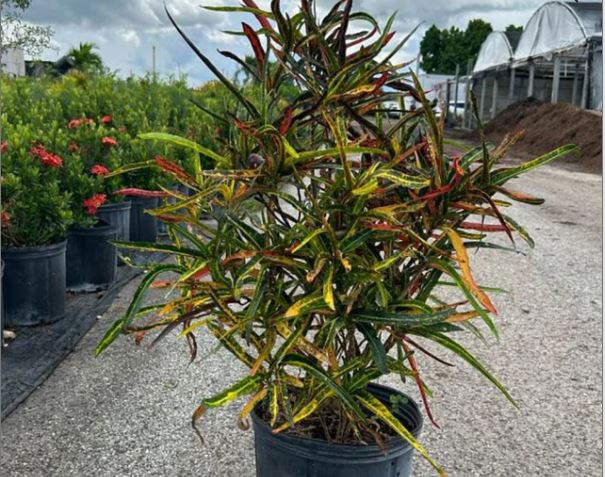
Croton is an extensive plant genus in the spurge family, Euphorbiaceae. The plants of this genus were described and introduced to Europeans by Georg Eberhard Rumphius. The common names for this genus are rushfoil and croton, but the latter also refers to Codiaeum variegatum. These plants are native to the tropical forests of Southeast Asia and the Pacific islands, including regions like Indonesia, Malaysia, and the Pacific islands.
The Zanzibar Croton, scientifically known as Codiaeum variegatum ‘Zanzibar’ has slender, narrow leaves and more subdued color palette compared to other Croton varieties. It features long, narrow leaves that taper to a point, somewhat resembling grass or reeds. The leaves are generally green with variegation in lighter green, yellow, or sometimes a hint of red or burgundy.
This variety tends to grow upright, potentially reaching heights of 3-5 feet indoors. Its slender leaves and growth habit give it a more refined, almost architectural appearance.
Like other Crotons, the Zanzibar Croton thrives in bright, indirect light. It can tolerate some direct sunlight, which might enhance the variegation, but too much direct sun can scorch the leaves. Insufficient light can lead to less vibrant variegation. It prefers to dry out slightly between waterings. Overwatering can lead to root rot, so good drainage is essential. Water thoroughly but allow the top inch or so of soil to dry before watering again.
Zanzibar Croton appreciates higher humidity levels. You can increase humidity by misting the leaves, placing the pot on a tray with pebbles and water, or using a humidifier, especially in dry indoor environments. It also prefers warm temperatures, ideally between 60-85°F (15-29°C). It’s not frost-tolerant, so it’s best kept indoors in cooler climates or in a protected spot outdoors in warmer climates.
A well-draining potting mix is necessary when growing this plant. A mix designed for tropical plants or a standard potting mix with added perlite or sand for better drainage works well.
Care Tips
- Fertilization: Feed with a balanced, water-soluble fertilizer during the growing season (spring through summer) every 2-4 weeks. Reduce or stop fertilization in the fall and winter.
- Pruning: Pruning can help maintain its shape and encourage bushier growth. Remove any damaged or discolored leaves to keep the plant healthy and vibrant.
- Toxicity: Like other Crotons, the Zanzibar Croton is toxic if ingested, so it should be kept out of reach of pets and children.
- Pests: Watch out for common houseplant pests like spider mites, scale, and mealybugs. Regularly inspect and clean the leaves to prevent infestations.
Why Choose Zanzibar Croton?
- Elegant Appearance: Its slender, variegated leaves offer a more sophisticated, less flamboyant look compared to other Croton varieties, making it ideal for minimalist or modern decor.
- Space Efficiency: Due to its upright growth, it can be a great choice for vertical gardening or for adding height to plant arrangements.
- Low Maintenance: While it has specific needs like most Crotons, the Zanzibar variety is relatively forgiving, making it suitable for both novice and experienced plant enthusiasts.
- Unique Texture: The narrow leaves provide a different texture and form, which can be a refreshing change from the broader leaves of other houseplants.